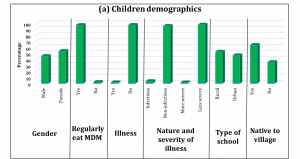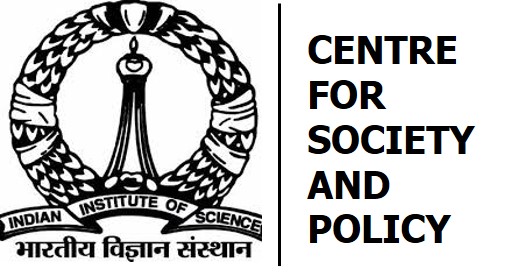Criticality of Midday Meals for School Children Post COVID-19*
Deepika Swami1, Anjula Gurtoo2
1 Post-doc Researcher, Centre for Society and Policy, Indian Institute of Science, India
2 Professor, Indian Institute of Science, India
Available online 19 June 2020
Cite this article as: Swami, D and Gurtoo, A. (2020). Criticality of Midday Meals for School Children Post COVID-19. IISc-CSP, Bangalore. 01C/06/2020. https://csp.iisc.ac.in/01C-06-2020/
Outline
Abstract
Introduction
- Criticality of school feeding programs
- Impact assessment of MDMS on child health and nutrition
- Defining ‘Normal’ and Preparedness for the post-pandemic world
Bibliography
Abstract
Food insecurity and poor nutrition are the major challenges in developing countries, specially India. In India, 14% population is undernourished, 38% of children under five are stunted, 21% are wasted and 51% of women in their reproductive age i.e., 15-49 years are anaemic which depicts the vulnerable state of child health and nutrition in India. India’s Mid-Day Meal (MDM) scheme which is the largest school feeding program in world, has proved to be quite effective in improving the child health and nutrition by alleviating classroom hunger and fulfilling the daily dietary requirements of children. However, the schools are closed from last five months due to COVID-19 pandemic which has high potential to aggravate child hunger and undernutrition resulting in impaired growth and reduced cognitive abilities of students. Although, number of studies have reported the negative effects of COVID-19 on livelihood, health, poverty and economy, the impact on child health due to nationwide school closure and the criticality of MDM amidst this crisis is understudied. Considering the severity of the problem pertaining to COVID-19 and MDM, this study aims to elucidate the significance of MDM via a case study of 594 children across eight states in India. Findings indicate the beneficiary impacts of MDM on reducing child stunting and wasting which necessitates the immediate requirement of MDM amidst this crisis as well as post-crisis. The study also answers whether India as a country is prepared for the situation post pandemic and also provides further directions to the government and policymakers towards effective implementation of the scheme across different regions in the country.
Introduction
As of June 12, 2020, the COVID-19 pandemic has resulted in approximately 7.27 million cases and 413,000 deaths globally. In response to the severe outbreak of COVID-19, 107 countries on March 12, 2020, temporarily closed their educational institutions affecting around 70% of the global student population. So far, more than 190 countries have implemented national school closure affecting 1.57 billion children, i.e., approximately 90% of the global student population [1].
School closures have deepened the nutritional crisis for 370 million children worldwide [2] and 100 million children in India who were mainly dependent on school meals for their daily dietary requirements [3]. The pandemic has induced a food crisis (hunger, and undernutrition), especially in children from low-income families. Mitigating the impacts of COVID-19 is a priority for the entire globe. However, while dwelling on one problem, we should avoid falling into another!
This paper deliberates how the pandemic will affect child health and nutrition due to multitude socio-economic reasons and empirically highlights the especial criticality of midday meals when the children will return to school. The COVID-19 induced economic crisis is one of the worst economic slowdowns to confront the world. Several companies have already announced job cuts, salary cuts, and office closures. The worst-hit from this crisis are the economically vulnerable populations, including the daily wage laborers, household domestic workers, street vendors, and micro enterprise owners [4]. Loss of livelihood is the direct impact, which has indirectly impacted their food and health security. Furthermore, According to the Centre for Monitoring Indian Economy [5], an estimated 122 million people will lose their jobs in the medium run and three-quarters of these will be small traders and daily wage labourers. This economic slowdown, along with long duration school closure, will aggravate the nutritional problem, especially for the children who were dependent on the school meals for part of their food and nutrition.
Criticality of school feeding programs
School feeding programs provide healthier meals and fulfil up to two-thirds of the child’s daily nutritional needs [6]. For children from lower-income families, having the meals from feeding programs such as the Midday Meal Scheme (MDMS) is not an option but a means for their survival. Malnutrition, undernutrition and dietary requirements of the 9.12 crore children from the disadvantaged section of the society has been effectively addressed via Mid-Day-Meal (MDM) scheme running over 11.35 lakh schools across India [7].
Even for a shorter time period, nutrition shortfalls can cause weakened immune system, fatigue, and risk of communicable disease, which may severely affect the physical, emotional, and psychological development of a child in the long-run. Malnourished and undernourished children are more susceptible to infection from COVID-19 due to their already impaired immune system. Prolonged crisis and unavailability of food via MDM will also lead to increased exploitation of the most vulnerable children groups, spread inequalities along with deepening the learning crisis. Lack of proper food, nutrition, and inaccessibility to school meals may push families towards negative coping strategies such as child labour, reduced frequency of meals, reduced intake of vegetables and fruits, which can weaken their immune system and increase health and life risks during this pandemic. In continuation to this, the current article presents the findings (via a case study) about how MDMS has led to improvement in health and nutrition of children.
Impact assessment of MDMS on child health and nutrition
A survey of 594 children carried out by the Akshaya Patra Foundation (TAPF) in Karnataka state of India demonstrates the criticality of the meal for children coming from low income families. The results indicate that consumption of MDM is associated with healthy weight of children in comparison to the children who does not consume MDM on regular basis. Fig. 1 provides the data demographics and the results are mentioned under Table-1.


Fig. 1: Children and parental demographics
Children demographics: Children demographics is presented in Figure 1(a) which shows that survey consisted of 45% male and 55% female children in the age group of 5-16 years. 97% of the children belonging to these households were consuming MDM on daily basis delineating the role of MDM to fulfil their daily dietary and nutritional needs. Out of these 594 children, only 2% were suffering from recurring illness depicting that consumption of MDM resulted in fewer cases of illness among children. Only 4% were suffering from infectious disease and 2% were having the major illness i.e., dengue, chest pain, and recurring fever from past three months while the rest showed non-infectious (~ 96%) and minor illness i.e., headache, fever, and cold for only one day (~98%). 53% of the children studying in school belonged to the rural region while 47% to the schools of urban region.64% of the children were native to the surveyed region i.e., Karnataka while 36% were migrants from Bihar, Andhra Pradesh, Jharkhand, Kerala, Orissa, Rajasthan, and Uttar Pradesh states of India (Fig. 1(a)).
Parental demographics: Parental demographics is presented in Figure 1(b) which shows that 78% of the households belonged to nuclear family while only 22% were part of joint family. In terms of fathers’ educational status, 23% of them were uneducated, 28% studied upto primary, 40% upto secondary and 8 % upto graduation. Fathers were working in wide range of occupations including daily wage labourer, construction labourer, farm labourer, auto driver, carpenter, factory worker, and a few as small retail shop owners. In terms of educational status of children’s mothers, 21% of them were uneducated, 31% have studied upto primary class, 40% upto secondary class, and 7 % upto graduation. As far as working status of mother is concerned, only 58% of the graduate mothers, 65% of the mothers who have studied upto secondary class, 81% of mothers who were studied upto primary, and 78% of uneducated mothers were working depicting the huge structural imbalance between mother and fathers’ working status (Fig. 1(b). Mothers were mostly found to be engaged as housemaid, factory worker, and daily wage labourer. While looking at the house ownership, 66% of them were in rented home while only 34% of them were living in their own home.29% of the households have only one working member, 61% have two, and 10% have three working members (Fig. 1(b). Income, working occupation, house ownership, and number of working members depict the poor economic status of the households.
Table-1: Logistic regression results for impact of MDM on height and weight of children (** denotes significance at 95%)

Analysis of the impacts of midday meal on height and weight of the children was done by categorizing the weight into five types, namely, severely underweight, underweight, average weight, overweight and obese, along with categorizing the height into five types, namely, severely stunted, stunted, average height, tall, and very tall. Multinomial logistic (MNL) regression was used to regress weight and height categories upon multiple independent variables including ‘regular consumption of MDM’. Results show (Table 1) that regular consumption of MDM reduces the probability of a child being underweight and obese and increases the probability of being in the average weight and overweight category .Similarly, consumption of MDM increases the probability of being in average height, and taller category (Table-1).
Overall, our research depicts the relevance and significance of MDM for better well-being of children manifesting as healthy weight and average height of children. Specifically, for low-income households, midday meals play a vital role in alleviating hunger, providing proper diet and improving the health and nutritional status of children.
Defining ‘Normal’ and Preparedness for the post-pandemic world
In the current pandemic era, when the nutritional support of the child has already weakened due to the disruption in schooling, what will “Normal” mean when the schools re-open? Pandemic situation is evolving in a linear manner, and there seems to be no end as of now. Still, if we look at the situation ideally and consider that the pandemic will get over within the next 2-3 months, then the question arises: are we, as a nation, prepared to handle the post pandemic nutritional damage on schools going children? If not, what should be our level of preparation for restoring the damage due to COVID-19? Anticipating that the pandemic situation will continue for a few more months, damage in the nutritional status of the child will directly impact their learning and well-being.
Even before the pandemic, India’s burden of child health and nutrition was more than any other country with casualties of 1.8 million children (below the age of five) every year, along with stunting rate of 52 million population [8]. Now, the situation has become far more complicated due to multiple stressors including COVID-19, impoverished economic status, loss of employment, poor and unhygienic living conditions, and lack of healthcare facilities. Overall, the combined impacts of all the stressors will further deteriorate the health and nutritional status of children and warrants immediate operationalization and implementation of MDM scheme across all the regions in coming days. However, only the effective implementation won’t give the complete solution to the problem as we even have to recover the damage that has already been done to child health due to unavailability of proper diet and food in these pandemic days. For example, this disruption in children’s nutritional levels has already resulted in higher prevalence of vitamin and mineral deficiency among children which needs to be dealt primarily to improve the health and nutritional status of the children. In line of this, the comprehensive solution would lie in enriching the nutritional contents of MDM by supplementing the existing menu with more fruits, milk, cereals and vegetables to compensate for the nutritional imbalance of the child due to COVID-19 which necessitates the additional funding from government and decision makers. At a broader level, better coordination between educational institutions and governmental agencies can strengthen this weak health and nutrition network for India and the globe.
Acknowledgment
* We gratefully acknowledge the discussions under the project, The Akshaya Patra Research Lab at Indian Institute of Science, Bangalore. The project is financially supported by The Akshaya Patra Foundation, India.
Bibliography
[1] UN Educational Scientific and Cultural Organization, “COVID-19 Educational Disruption and Response,” UNESCO, 2020. [Online]. Available: https://en.unesco.org/covid19/educationresponse.
[2] World Food Programme, “World Food Programme,” United Nations, 2020. [Online]. Available: https://www.wfp.org/countries/india.
[3] T. Adrian and F. Natalucci, “COVID-19 Crisis Poses Threat to Financial Stability,” International Monetary Fund, 2020. [Online]. Available: https://blogs.imf.org/2020/04/14/covid-19-crisis-poses-threat-to-financial-stability/..
[4] M. Vyas, “The jobs bloodbath of April 2020,” Centre for Monitoring Indian Economy, May-2020.
[5] C. G. Dunn, R. D. E. Kenney, S. E. Fleischhacker, and and S. N. Bleich, “Feeding Low-Income Children during the Covid-19 Pandemic,” N. Engl. J. Med., vol. 40, no. 1, pp. 1–2, 2020.
[6] B. Mathur, “National Nutrition Month: 10 Things To Know About India’s Mid-Day Meal Scheme, World’s Largest School Feeding Program,” 2019. [Online]. Available: https://swachhindia.ndtv.com/national-nutrition-month-things-to-know-about-india-mid-day-meal-scheme-world-largest-school-feeding-program-38040/..
[7] V. K. Paul et al., “Reproductive health, and child health and nutrition in India: Meeting the challenge,” Lancet, vol. 377, no. 9762, pp. 332–349, 2011.
Social media
Article metrics on Twitter
A feature article addressing food security for Indian children, from the Centre for Society and Policy, IISc. 'Criticality of Midday Meals for School Children Post COVID-19'. Prof @Anjula_G; Deepika Swami; @IISc_CSP; @IIScBangalore; @AkshayaPatra.https://t.co/U1sOOiTK9W pic.twitter.com/6PoZwgbrkl
— IISc-CSP (@IISc_CSP) June 19, 2020


